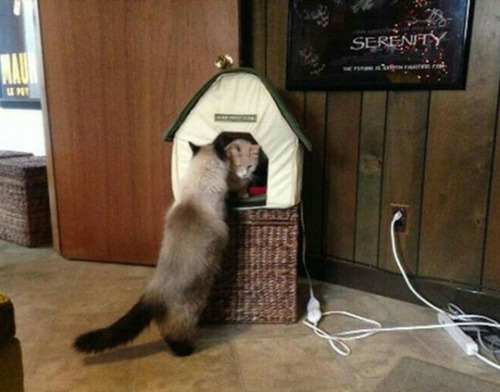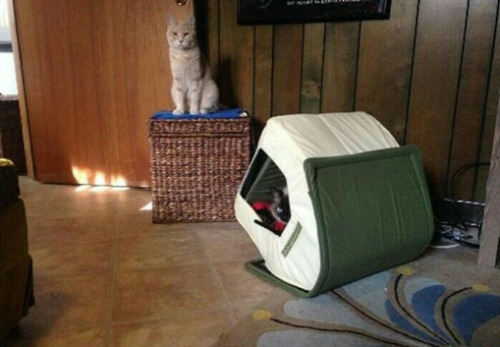Always A Better Tomorrow
Always a better tomorrow
A Hitchhiker’s Ride to Space
This month, we are set to launch the latest weather satellite from the National Oceanic and Atmospheric Administration (NOAA). The Joint Polar Satellite System-1, or JPSS-1, satellite will provide essential data for timely and accurate weather forecasts and for tracking environmental events such as forest fires and droughts.

Image Credit: Ball Aerospace
JPSS-1 is the primary satellite launching, but four tiny satellites will also be hitchhiking a ride into Earth orbit. These shoebox-sized satellites (part of our CubeSat Launch Initiative) were developed in partnership with university students and used for education, research and development. Here are 4 reasons why MiRaTA, one of the hitchhikers, is particularly interesting…

Miniaturized Weather Satellite Technology
The Microwave Radiometer Technology Acceleration (MiRaTA) CubeSat is set to orbit the Earth to prove that a small satellite can advance the technology necessary to reduce the cost and size of future weather satellites. At less than 10 pounds, these nanosatellites are faster and more cost-effective to build and launch since they have been constructed by Principal Investigator Kerri Cahoy’s students at MIT Lincoln Laboratory (with lots of help). There’s even a chance it could be put into operation with forecasters.

The Antenna? It’s a Measuring Tape
That long skinny piece coming out of the bottom right side under MiRaTA’s solar panel? That’s a measuring tape. It’s doubling as a communications antenna. MiRaTA will measure temperature, water vapor and cloud ice in Earth’s atmosphere. These measurements are used to track major storms, including hurricanes, as well as everyday weather. If this test flight is successful, the new, smaller technology will likely be incorporated into future weather satellites – part of our national infrastructure.

Tiny Package Packing a Punch MiRaTA will also test a new technique using radio signals received from GPS satellites in a higher orbit. They will be used to measure the temperature of the same volume of atmosphere that the radiometer is viewing. The GPS satellite measurement can then be used for calibrating the radiometer. “In physics class, you learn that a pencil submerged in water looks like it’s broken in half because light bends differently in the water than in the air,” Principal Investigator Kerri Cahoy said. “Radio waves are like light in that they refract when they go through changing densities of air, and we can use the magnitude of the refraction to calculate the temperature of the surrounding atmosphere with near-perfect accuracy and use this to calibrate a radiometer.”

What’s Next?
In the best-case scenario, three weeks after launch MiRaTA will be fully operational, and within three months the team will have obtained enough data to study if this technology concept is working. The big goal for the mission—declaring the technology demonstration a success—would be confirmed a bit farther down the road, at least half a year away, following the data analysis. If MiRaTA’s technology validation is successful, Cahoy said she envisions an eventual constellation of these CubeSats orbiting the entire Earth, taking snapshots of the atmosphere and weather every 15 minutes—frequent enough to track storms, from blizzards to hurricanes, in real time.
Learn more about MiRaTA
Watch the launch!

The mission is scheduled to launch this month (no sooner than Nov. 14), with JPSS-1 atop a United Launch Alliance (ULA) Delta II rocket lifting off from Space Launch Complex 2 at Vandenberg Air Force Base in California. You’ll be able to watch on NASA TV or at nasa.gov/live.

Watch the launch live HERE on Nov. 14, liftoff is scheduled for Tuesday, 4:47 a.m.!
Make sure to follow us on Tumblr for your regular dose of space: http://nasa.tumblr.com.
More Posts from Duxgregis and Others
I really think I've exhausted the list of WWII documentaries, fiction films, docu-dramas, government films, and television series. And WWII alternate universe stories too. Damn... #NerdConfessions
Any guy: I love history, I find it really interesting. Especially-
Me cutting him off, rubbing my temples: especially World War II. Yeah




(via BoringEnormous)











a brief departure from the typical posts here…
while i try not to include my personal work in subtilitas, readers may have noticed content has been a little sparse here lately, largely due to a few large projects wrapping up. one of which is a book i’ve been involved with through the cactus store, which was just released this week.
xerophile is a compendium of desert plant and habitat photography three years in the making. a selection of over five hundred photographs of arguably the rarest and most bizarre plants on earth, photographed in their remote natural habitats over the past 80 years by a global cadre of obsessed cactus aficionados made up of both the amateur and the professional—from phd. botanist to banker, art teacher to cancer researcher. aside from the field photography, we’ve also included several interviews with the explorer’s themselves, who’s stories only add to the mystique of their images.
posts should begin to be more regular next week. thanks as always for reading.
Some basic science 🤓
Astronomy and Astrophysics: Facts
Here is a list of some curiosities of astronomy and astrophysics. From our solar system to interstellar space.

Mercury is shrinking: It’s small, it’s hot and it’s shrinking. A NASA-funded research suggests that Mercury is still contracting today, joining Earth as a tectonically active planet.

Stellar neighbor: Proxima Centauri is a red dwarf, a small low-mass star, about 4.25 light-years (1.30 pc) from the Sun in the constellation of Centaurus. Proxima Centauri is the nearest star of the Sun that is known and at first can only be seen from the Southern Hemisphere.

A heavy star: 5 milliliters, or one teaspoon of neutron star material, equals the weight of about 900 Great Pyramids of Giza. One sugar cube equates to 100 billion tons. A cubic meter? The entire weight of the Atlantic Ocean. With an escape velocity of 100,000 km/s (Earth’s is a puny 11.3 km/s), a fall from 1 meter above a neutron star would only take one microsecond, and you would impact at around 2000 km/s, or 7.2 million kilometers per hour. This force would destroy all your component atoms, rendering all your matter identical. Fortunately, the closest neutron star is rather far away (about 400 light-years), so I wouldn’t be too concerned about the aforementioned event.

Asteroid belt: The asteroid belt is the circumstellar disc in the Solar System located roughly between the orbits of the planets Mars and Jupiter. It is occupied by numerous irregularly shaped bodies called asteroids or minor planets. About half the mass of the belt is contained in the four largest asteroids: Ceres, Vesta, Pallas, and Hygiea. The total mass of the asteroid belt is approximately 4% that of the Moon, or 22% that of Pluto, and roughly twice that of Pluto’s moon Charon (whose diameter is 1200 km).

Sunlight Takes Around 8 Minutes To Reach Earth: The Earth is located 93 million miles (150 million kms) away from the Sun, a distance known to astronomers as an astronomical units or AU. Traveling at the speed of light (186,282 miles per second), sunlight is able to cross this vast distance in around 8 minutes 20 seconds.

Pluto is about 2,376 km in diameter. Pluto’s small size and low mass mean that it has a density of 1.86 grams per cubic centimeter according to recent measurements by New Horizons, about 40 percent of Earth’s density.

Just like black holes; neutron stars also generate gravitational waves: This year astronomers were able to detect gravitational waves originating from neutron stars. And in addition, it was possible to observe the location of the collision thanks to the efforts of the astronomers. This is a great advance for astronomy.

Most neutron stars are very fast rotators: Since the conservation of angular momentum following a supernova explosion transfers the progenitor star’s rate of rotation to the remnant that is only about 20 km (12.5 miles) in diameter, the result is that the neutron star rotates very rapidly when it is formed. Most known neutron stars rotate several hundred times per second, but the fastest rotator yet discovered, the neutron star designated PSR J1748-2446ad, is known to rotate 716 times per second, which translates into 43,000 rotations per minute, or 24% of the speed of light at the star’s equatorial surface.

Asteroid also has satellite: This color picture is made from images taken by the imaging system on the Galileo spacecraft about 14 minutes before its closest approach to asteroid 243 Ida on August 28, 1993. Ida’s moon, Dactyl, was discovered by mission member Ann Harch in images returned from Galileo. It was named after the Dactyls, creatures which inhabited Mount Ida in Greek mythology. Ida has an average diameter of 31.4 km (19.5 mi). It is irregularly shaped and elongated, and apparently composed of two large objects connected together. Its surface is one of the most heavily cratered in the Solar System, featuring a wide variety of crater sizes and ages.

Kepler-444 system: The oldest known planetary system has five terrestrial-sized planets, all in orbital resonance. This weird group showed that solar systems have formed and lived in our galaxy for nearly its entire existence. Estimated to be 11.2 billion years old (more than 80% of the age of the universe), approximately 117 light-years (36 pc) away from Earth in the constellation Lyra.
Sources: wikipedia, space.com, futurism.com and astronomytrek.com
Image credit: NASA/JPL, ESO/M. Kornmesser, NASA/XMM Newton, Casey Reed/Penn State University, NASA/ESA/Hubble
To learn more about the shrinkage of Mercury, click here.
To learn more about the gravitational waves generated by neutron stars click here.










Delicate Temporary Tattoos That Look Like Real Watercolor Illustrations
London-based brand and temporary tattoo designers PAPERSELF prides itself in the creation of artistic temporary tattoos. Adorned with soft pastels and inspired by nature, the watercolor-like temporary tattoos are unique. They follow the new trend of artistic temporary tattoos, which mimic the delicacy of watercolor paintings. Find their entire collection in their Etsy shop.
View similar posts here!
Gifts for every budget
Personalized and custom jewelry
Jewelry shop
Gifts for her
Home gallery
Topic: Etsy, Illustration, Temporary Tattoos, Tattoos || by STAFF
My kind of lady

Happy birthday, Marie Curie! In 1903, Curie and her husband shared a Nobel Prize in Physics for the discovery of radium and polonium. She was the first woman to win this award and later, the first woman to become a professor at the University of Paris. In 1911 she won another Nobel Prize, this time in chemistry, for producing radium as a pure metal and for further studies on radioactive elements. During World War I, she devoted herself to using radioactivity to help people. She set up mobile x-ray vehicles for soldiers in France, which were nicknamed petites Curies (“little Curies”). In the 1920s, radium was considered a miracle cure—you could even buy “Radium” brand butter, cigarettes, and beer. We now know that radioactivity itself causes cancer, but thanks to Curie, radiation therapy is still used today as an effective way to target cancerous tissues. Photo: Tekniska museet

Mustard gas and roses - Slaughter House 5 by Kurt Vonnegut
Candle + Book Giveaway

Hey everyone! The Literary Snob is teaming up with The Happy Bard Candle Co. to do a double giveaway this September. We’re all on the same trivia team in the real world (Sean Bean Lives!) and I absolutely love Happy Bard’s literary inspired candles. They’re about to release their next line of literary candles and one of the new scents will be a fan submission! So we’re holding a contest and double giveaway to find the fairest combo in the land.
Reblog this post with your submission for a literary candle scent. You can send in as many submissions as your heart desires and tag anyone who dreams of being a candle virtuoso. The Happy Bard Candle Co. will pick their favorite submission at the end of the contest, create the candle, and send it to you! Plus I will send the winner one of the newly released Vintage Minis of your choice.
GIVEAWAY RULES
Reblog this post with a book & fragrance combo suggestion
Follow The Happy Bard Candle Co. on either Instagram or Facebook
Follow The Literary Snob on Tumblr
Have fun and be creative!
RULES
There is no limit on submissions, so reblog away! Currently, The Happy Bard Candle Co. cannot ship internationally, so anybody can participate but only those in the U.S. can win. Contest ends Saturday, Sept. 30 at midnight.
We look forward to seeing what everyone comes up with! Plus I might throw in an extra prize for whoever makes me laugh the hardest. Good luck!
Helicopters Arrive at National Archives for Exhibit Opening

Last night, the North Carolina Vietnam Helicopter Pilots Association installed three Vietnam War-era aircraft on the lawn of the US National Archives. The Vietnam veterans will be giving tours of the helicopters starting today and the “Remembering Vietnam” exhibit opens to the public this Friday, November 10.
Read more about the exhibit opening here. See a timelapse of the helicopter installation on the National Archives Foundation Facebook page.

Nicole and Chloë love the new apartment look. (at Aspire)
-
 lightspacedream liked this · 1 year ago
lightspacedream liked this · 1 year ago -
 wannababe-mama liked this · 4 years ago
wannababe-mama liked this · 4 years ago -
 chiqui-rata liked this · 6 years ago
chiqui-rata liked this · 6 years ago -
 the-blink182-blog liked this · 6 years ago
the-blink182-blog liked this · 6 years ago -
 whoa-who-am-i liked this · 6 years ago
whoa-who-am-i liked this · 6 years ago -
 rbndahood liked this · 7 years ago
rbndahood liked this · 7 years ago -
 fleurdebach5-blog liked this · 7 years ago
fleurdebach5-blog liked this · 7 years ago -
 alcorandmizar liked this · 7 years ago
alcorandmizar liked this · 7 years ago -
 restlesspacing-blog liked this · 7 years ago
restlesspacing-blog liked this · 7 years ago -
 aacreep liked this · 7 years ago
aacreep liked this · 7 years ago -
 sciencethot reblogged this · 7 years ago
sciencethot reblogged this · 7 years ago -
 rakanisu liked this · 7 years ago
rakanisu liked this · 7 years ago -
 asuitcaseofravens liked this · 7 years ago
asuitcaseofravens liked this · 7 years ago -
 lesbianspacecat liked this · 7 years ago
lesbianspacecat liked this · 7 years ago -
 ultra-piter-stuff liked this · 7 years ago
ultra-piter-stuff liked this · 7 years ago -
 ejnuyc reblogged this · 7 years ago
ejnuyc reblogged this · 7 years ago -
 ejnuyc liked this · 7 years ago
ejnuyc liked this · 7 years ago -
 a-list-of-yellow-things liked this · 7 years ago
a-list-of-yellow-things liked this · 7 years ago -
 aahhdummb liked this · 7 years ago
aahhdummb liked this · 7 years ago -
 abhishekmishraw liked this · 7 years ago
abhishekmishraw liked this · 7 years ago -
 squireren-blog liked this · 7 years ago
squireren-blog liked this · 7 years ago -
 iratablog liked this · 7 years ago
iratablog liked this · 7 years ago -
 the-dreadful-rauw-blog liked this · 7 years ago
the-dreadful-rauw-blog liked this · 7 years ago -
 hiphop1986 reblogged this · 7 years ago
hiphop1986 reblogged this · 7 years ago -
 mrmoellermachtmatschkuchen liked this · 7 years ago
mrmoellermachtmatschkuchen liked this · 7 years ago -
 shirekat reblogged this · 7 years ago
shirekat reblogged this · 7 years ago -
 phatbass58 liked this · 7 years ago
phatbass58 liked this · 7 years ago -
 lefoujd liked this · 7 years ago
lefoujd liked this · 7 years ago -
 atuldave liked this · 7 years ago
atuldave liked this · 7 years ago -
 114liebeslieder liked this · 7 years ago
114liebeslieder liked this · 7 years ago -
 verycharismaticdragon liked this · 7 years ago
verycharismaticdragon liked this · 7 years ago -
 cohobbitation reblogged this · 7 years ago
cohobbitation reblogged this · 7 years ago -
 nocti-x-blog liked this · 7 years ago
nocti-x-blog liked this · 7 years ago -
 catyuy reblogged this · 7 years ago
catyuy reblogged this · 7 years ago -
 xyhor-astronomy reblogged this · 7 years ago
xyhor-astronomy reblogged this · 7 years ago -
 dbird051077 liked this · 7 years ago
dbird051077 liked this · 7 years ago